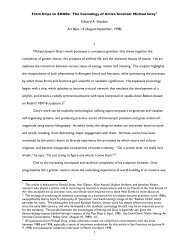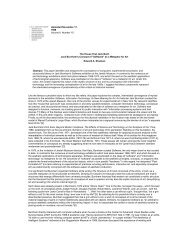Cybernetics and Art: Cultural Convergence in the ... - Edward Shanken
Cybernetics and Art: Cultural Convergence in the ... - Edward Shanken
Cybernetics and Art: Cultural Convergence in the ... - Edward Shanken
You also want an ePaper? Increase the reach of your titles
YUMPU automatically turns print PDFs into web optimized ePapers that Google loves.
concept of durée. The “need to make ideas solid . . . but <strong>in</strong>terfusable”suggests <strong>the</strong> modular, concrete aes<strong>the</strong>tic of constructivism. The“<strong>in</strong>tention to make movement a subtle but essential part of anartifact” shares concerns <strong>in</strong> common with earlier <strong>and</strong> synchronousdevelopments <strong>in</strong> contemporary art <strong>in</strong>ternationally, which sought tovitalize art through movement, enactment, <strong>and</strong> performativeelements. Ultimately, Ascott would extend <strong>the</strong> search for “patternsof connections” to draw parallels between <strong>the</strong> forms of art <strong>and</strong> <strong>the</strong>forms of science: for example, <strong>the</strong> “ultimate shapes” <strong>in</strong> <strong>the</strong> ChangePa<strong>in</strong>t<strong>in</strong>gs <strong>and</strong> <strong>the</strong> analog wave patterns that represent <strong>and</strong> carry<strong>in</strong>formation <strong>in</strong> communications systems.Indeed, Ascott developed a taxonomy of “analog forms”which, like waveforms, were meant symbolically to convey universalqualities, potentials, <strong>in</strong>tentions, <strong>and</strong> strategies. In works like VideoRoget (1962) a moveable calibrator at <strong>the</strong> center of <strong>the</strong> piece enabled<strong>the</strong> relationships among <strong>the</strong> analog forms (<strong>and</strong> categories of mean<strong>in</strong>g)to be varied by <strong>the</strong> user. On <strong>the</strong> page preced<strong>in</strong>g <strong>the</strong> reproduction ofVideo Roget <strong>in</strong> <strong>the</strong> exhibition catalog, <strong>the</strong> artist provided a relateddiagram on trac<strong>in</strong>g paper, entitled Thesaurus (1963). The reader could<strong>in</strong>teract with <strong>the</strong> Thesaurus by superimpos<strong>in</strong>g it on <strong>the</strong> image of VideoRoget to reveal suggested mean<strong>in</strong>gs of <strong>the</strong> <strong>in</strong>dividual analog forms <strong>and</strong><strong>the</strong> possible feedback loops among <strong>the</strong>m (Plate 5).Ascott extended <strong>the</strong> parallel he drew between <strong>the</strong> forms ofart <strong>and</strong> science to <strong>in</strong>clude non-western systems of knowledge as well.The phrase “To programme a programm<strong>in</strong>g programme” appears ona 1963 sketch for <strong>the</strong> 1964 construction For Kamyn<strong>in</strong>, Lyubimskii <strong>and</strong>Shura-Bura, dedicated to <strong>the</strong> Russian computer scientists. Yet despite<strong>the</strong> scientific jargon, <strong>in</strong> this work <strong>and</strong> o<strong>the</strong>rs from <strong>the</strong> 1960s <strong>and</strong>1970s, Ascott visually suggested equivalences between I Ch<strong>in</strong>ghexagrams, b<strong>in</strong>ary notation of digital computers, scatterplots ofquantum probability, wave frequencies, <strong>and</strong> biomorphic shapes (Plate6). Two years later Korean-born artist Nam June Paik drew a strik<strong>in</strong>gparallel between Buddhism <strong>and</strong> cybernetics:Cybernated art is very important, but art for cybernated life ismore important, <strong>and</strong> <strong>the</strong> latter need not be cybernated. . . .<strong>Cybernetics</strong>, <strong>the</strong> science of pure relations, or relationshipitself, has its orig<strong>in</strong> <strong>in</strong> karma. . .The Buddhists also sayKarma is samsaraRelationship is metempsychosis 25In a similar way, Ascott’s <strong>the</strong>oretical-artistic propositions about <strong>the</strong>future comb<strong>in</strong>ed recent advances <strong>in</strong> science <strong>and</strong> technology withancient systems of knowledge, <strong>and</strong> did so <strong>in</strong> a non-hierarchicalmanner. Like an appropriate response to a koan, an apparentparadox that cannot be resolved by logical formula, Ascott’samalgamation of science, art, <strong>and</strong> mysticism never sought anunequivocal resolution of <strong>the</strong>se seem<strong>in</strong>gly irreconcilable systems ofknowledge. Ra<strong>the</strong>r, hav<strong>in</strong>g <strong>in</strong>tuited <strong>the</strong> paradoxical nature ofknowledge, he attempted to better underst<strong>and</strong> <strong>the</strong> underly<strong>in</strong>g systemsby which mean<strong>in</strong>g is constructed.Cybernetic Systems, Semantic Systems, <strong>and</strong> Their DiscontentsIn works like Video Roget (Thesaurus) Ascott equated visual9





